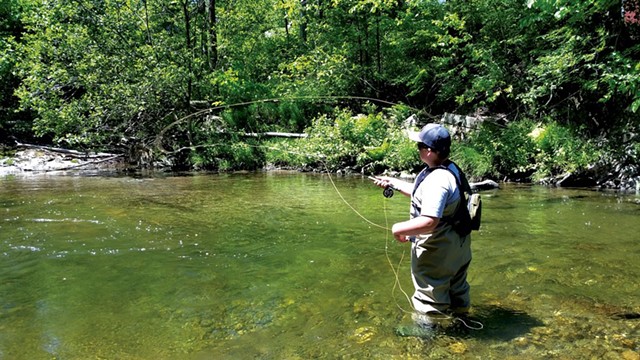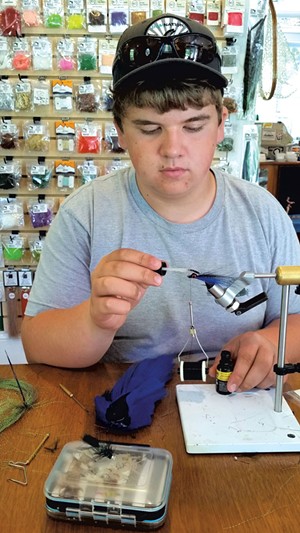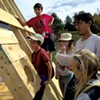Published June 30, 2015 at 10:00 a.m.
The difference between fly fishing and reel fishing isn't just about gear or technique; it's about philosophy. That much becomes clear after talking to 14-year-old Zach Favreau. "With fly fishing, you're a lot closer to the fish and you can almost see it from how they see it," he told me. "Instead of just sitting on a shore, you're in the stream, in the fish's environment."
Zach, who lives in Georgia, Vt., agreed to spend a sunny Saturday morning in Jeffersonville teaching me about the sport. He learned to fly fish four years ago at the Green Mountain Fly Fishing Camp, a weeklong summer program for kids ages 11 to 15 in Groton State Forest.
Camp founder and director Chris Lynch, the manager of Green Mountain Troutfitters in Jeffersonville, barely advertises. Yet all three of his summer sessions are usually booked up by January. The camp attracts kids from all over the country, and almost all first-time campers return for another year.
These kids are passionate about the sport, sometimes keeping at it for 15 hours a day with only small breaks for meals, says Lynch. Many campers voluntarily get up at 6 a.m. to fish before breakfast. They end each day at 9 p.m. after fishing from rowboats on Noyes Pond, right outside their lodge.
During breaks from fishing, campers learn how to tie their own flies. No actual insects are involved; "flies" are made out of a mix of natural and synthetic materials. The idea is to create something flashy that will make a fish believe it is catching a real fly.
The key to tying a successful fly is to create something that looks like it came from the natural world. In the backroom of Green Mountain Troutfitters, Zach used a fly-tying vice, thread, beads and several specialized tools to show me how to tie a "woolly bugger," a black-and-green fly that resembles fish food.
The woolly bugger is particularly versatile, Lynch explained, because "it could be a leech, it could be a bait fish, or just something that gets in the fish's face and makes him angry and want to strike." After about 10 minutes of working on it, Zach held up a tiny, delicate piece of art that he might very well sacrifice to the river right after he casts it.
"It's better not to get too attached," Lynch explained.
Choosing which fly to use is just as important as tying the fly. Successful fly fishermen and -women develop a sophisticated understanding of the river ecosystem. In other words, in order to trick a fish into biting their fly, they need to think like a fish. Zach says he and fellow campers have to learn what bugs are hatching, how the temperature and volume of the water affect the fish's behavior and where fish are most likely to swim and feed.
After putting on hip waders and boots, Zach and I walked down to the Brewster River. He waded up to his waist into the center of the stream and began casting in a slow deliberate circle, showing me the spots where the trout would most likely be. "You see up there?" he gestured to the darker, shallower section of the water underneath an overhanging rock. "That's where you want to put your bug imitators."
As I stood half-submerged next to Zach, feeling the late spring sun on my back and listening to the water rush past me, I started to understand why this sport might elicit such intense dedication.
We didn't catch anything, but that didn't bother Zach. Hanging out in the river on a beautiful summer day seemed to be its own reward.
"The fish are just a bonus," Lynch explained when we peeled off our wet boots inside the shop. "A big part of it is just for the places that it takes us."
Green Mountain Fly Fishing Camp, ages 11-15, Groton State Forest, gmffc.com Vermont TU Trout Camp, ages 13-16, Quimby Country Lodge, vermonttroutcamp.com
This article was originally published in Seven Days' monthly parenting magazine, Kids VT.
More By This Author
Speaking of KidsVT - Camps,
-

Camp Thorpe Offers Summer Fun to Those With Special Needs
Apr 7, 2020 -

Teens Bond With the Bard at Shakespeare Camp
Mar 3, 2020 -

Get Psyched for Summer With These Camp-Themed Reads
Jan 28, 2020 -

Fun for Everyone: Partners in Adventure Helps Young People With Special Needs Experience the Joy of Camp
Apr 30, 2019 -

Easy Does It: Camp Staffers Share the Sweet and Simple Activities That Make Summer Memories
Apr 2, 2019 - More »
Comments
Comments are closed.
From 2014-2020, Seven Days allowed readers to comment on all stories posted on our website. While we've appreciated the suggestions and insights, right now Seven Days is prioritizing our core mission — producing high-quality, responsible local journalism — over moderating online debates between readers.
To criticize, correct or praise our reporting, please send us a letter to the editor or send us a tip. We’ll check it out and report the results.
Online comments may return when we have better tech tools for managing them. Thanks for reading.
















































